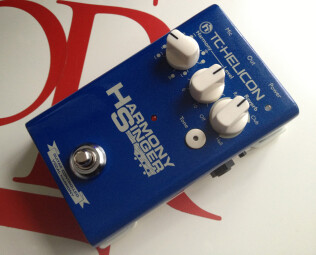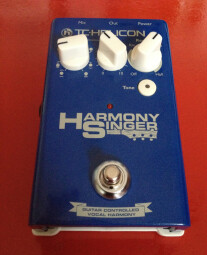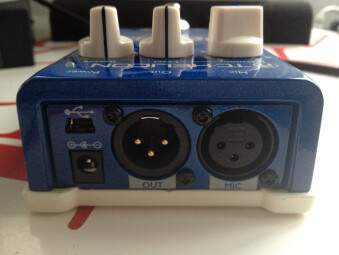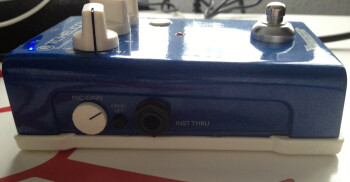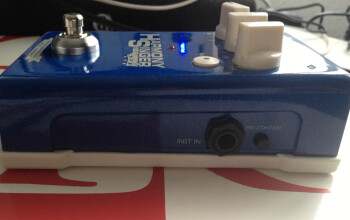More than half of the guitarists in this world sing. Based on this survey, TC-Helicon designed the Harmony Singer, a compact pedal with reverb and 2 voice harmonies based on guitar chords. This isn’t TC-Helicon first try, so what’s new?
A vocal processor with guitar-based harmonies is nothing new for TC-Helicon. VoiceWorks (rack format) already offered 4 voice harmonies ten years ago. Then came VoiceLive and this year, VoiceLive Touch 2.
At the same time the Canadian manufacturer thought about the singing guitarist players out there with pedalboards and a tight budget, and brought out the VoiceTone, with reduced functions and just two or three effects. The H1, shown at Musikmesse 2011, proposed two part harmonies based on guitar chords. Two years later, TC-Helicon, again at Musikmesse, showed us the successor of this compact pedal, Harmony Singer, with an onboard reverb.
Blue Harmony
Out of the box the TC-Helicon Harmony Singer shows off its blue package with white knobs and lettering, a metal “stompable” footswitch and red and green LEDs. It uses a metal chassis, which is the reason for its weight, and there is a large skid proof band on the back keeping it in place. It’s definitely a robust piece of equipment. A label on the back panel also indicates that it was made in Thailand.
The three knobs for Harmony, Level and Reverb are sturdy and stable, without being too stiff. Just underneath you’ll find a little white dial for Tone with a red LED in the center and situated far enough away from the footswitch so as not to inadvertently trigger it.
On the right side you’ll find the 1/4" guitar input jack, and a push-button Mic Control that allows for remote control effects using TC-Helicon MP-75 and Sennheiser e835 fx mics.
There is a 1/4" Guitar Thru jack on the left, Ground Lift button to eliminate parasitic noise and a flat white fader for mic level. The flat form, sturdiness and location gives an impression of security. You won’t accidentally modify the level, but those big rushed fingers might find it difficult to quickly adjust, specially in live situations.
Last, the back gives access to an XLR mic input, an XLR output, a mini-USB for VoiceSupport software updates, and the power connector. Condenser mics are accepted, the onboard phantom power is automatically engaged when the mic is plugged in.
No guitar level? That’s right, since the guitar only serves to feed the tone detection circuit. If you don’t pass through the Guitar Thru, no one will hear you. A short note for those who want to insert the Harmony Singer into their pedal chain, TC-Helicon states that it must be the first one in line. It has the same dimensions as the VoiceTone, so it will fit onto the pedalboard with no problem.
Let’s go……plug in the jacks and XLR, the wall wart (the pedal has no on/off switch), lights, action, music!
Harmony Central
Once the pedal is lit up and the mic level is set, you have two crucial choices. How much reverb to use and which harmonies? In fact, Harmony Singer offers three types of reverb: Room, Club and Hall, which can be adjusted at will, since the knob is not notched, and 8 voice of harmony via a notched knob, from very low to very high.
You can choose a single voice, two highs or lows, or mix a high and a low voice. Available voices are represented by a short line above and below a small white dot (representing you) at each knob position, the farthest for the low and high-end and the closest for the least lows/highs. The volume knob in the middle adjusts the harmony output level.
Last dial is Tone, always active, and offering two distinct equalizations with a compressor which adapts itself to the gain sent by the mic. You won’t accidentally overload the PA. If you have too much monitor effect or just want to cut some lows, press the Tone (LED lights up), equalization changes by slightly increasing the medium high frequencies and giving the dry voice more “air”. I couldn’t get the exact details about the frequency adjustments, but you do hear the difference. All this really works in a live situation. I sang very loud, standing very close to the mic, and no clipping! Let’s listen.
Sweet Harmonies
The Harmony Singer lets you use the reverb by itself or with the harmonies. The footswitch lets you command the effects, with a long press activating bypass for public address.
When you use the reverb alone, the central LED doesn’t light up. It will turn red when you activate harmonies via a second foot stomp. This is a good way to call up your harmonies on a dark stage.
Here are some sound examples using a Neumann KMS 105 mic, a Taylor 512C guitar with a piezo Fishman pickup mounted underneath the bridge. The Harmony Singer is plugged into the mic/instrument input from a Focusrite Saffire Pro 24 using XLR and the sounds recorded with Studio One 2.5, at 0dB with no audio treatment:

- HS Children 00:50
- HS Crying 00:25
- HS Rolling 00:50
- HS Kiss 00:53
- HS Doors 00:30
- Tone Boogie 00:22
- Tone Café 00:43
The harmonies are very effective; the bass voices add body when singing in the alto/mezzo range and is very present when singing highs, all with a very pleasant realism. The highs do a nice job as well, with a preference for the least high pitched, being a woman, the soprano harmony sometimes sounded a bit like a robot. It’s up to you to decide which harmonies to use depending on your musical style and voice.
Warning! Reactivity also means very sensitive detection. One note out of tune and your backup singers will be way out to lunch and as usual with vocal processors, the harmony correction might be quick, but it sounds very unnatural.
Also, guitar playing must remain intelligible for the integrated harmony detector to do its job with the tonic and thirds, if you want to avoid surprises. In fact, unlike to the H1, you can not define a key by hand on the Harmony Singer. The internal circuits detect the harmonies from the chords played on the guitar. Strumming works better than picking, even though it is possible, the harmonies will not follow fast picking. If you want to start with voices only, play the first chord of the song with the guitar muted otherwise the harmonies will use the last chord played as a reference.
One word also about the reverb, which is very nice. Even with the Tone function activated and singing in the high range, the voice doesn’t loose any consistency. Used with the harmonies, it isn’t muddy. A good point here too.
All Together Now
With Harmony Singer, TC-Helicon offers guitar players/singers the two indispensable effects for solo gigs or with groups with no backup singers: 3 types of reverb and 2 part harmony with 8 possibilities. And both have excellent quality. Add that to adaptable equalization, compressor, the fact that the pedal can be inserted into a pedalboard, it’s sturdy, compact and only costs $199.00.
All these qualities may tend to make you forget the little setbacks like harmony changes being a bit abrupt and unnatural, or the fact that creating harmonies with picking is very difficult. But remember, there’s electronics inside this little blue box, not a human who already knows the song. We had some reservation about the mic level adjust, which is minimal but safe at the same time. While the jury may still be out at Musikmesse, we give it its first prize!
Download audio files (FLAC format)


